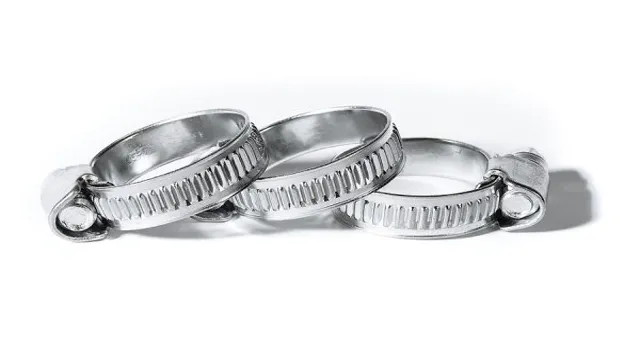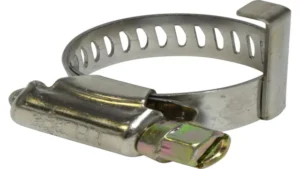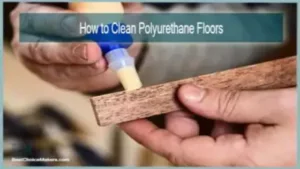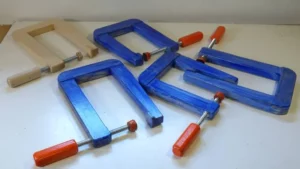As a car owner, maintaining the engine is crucial to keep it in good condition and avoid any damages that could lead to costly repairs. Among the many parts of the engine, the radiator system plays a critical role in regulating the temperature and preventing overheating. The radiator hoses, in particular, are essential components that carry coolant fluid to and from the engine block.
However, to ensure a leak-free connection, radiator hose clamps are needed. But the question is, how tight should radiator hose clamps be? In this blog post, we will explore the answer to this pressing question and provide useful tips on how to properly tighten radiator hose clamps.
Understanding Radiator Hose Clamps
When it comes to radiator hose clamps, understanding how tight they should be can be confusing. While it’s important to ensure a secure connection between the hose and the radiator, over-tightening the clamp can be just as problematic as a loose clamp. Generally, the clamp should be tightened until it’s snug but not overly tight.
Ideally, the hose should be able to move slightly with gentle pressure. Over-tightening the clamp can cause the hose to become pinched, which can restrict coolant flow and lead to overheating. On the other hand, a loose clamp can lead to leaks and potential engine damage.
It’s important to find the sweet spot where the clamp provides enough pressure to prevent leaks but not so much pressure that it damages the hose or restricts coolant flow. When in doubt, consult your vehicle manufacturer’s guidelines to ensure you’re using the appropriate clamp tightness for your specific vehicle.
Function of Radiator Hose Clamps
Radiator Hose Clamps Radiator hose clamps are essential components of any cooling system, as they keep the radiator hoses securely attached to the engine. They come in various designs, including screw-type and spring-type clamps, each offering unique benefits. Screw-type clamps are more popular, as they allow for easy adjustment to ensure a tight fit, and can be used with a range of hose sizes.
The spring-type clamps, on the other hand, are pre-set at a particular diameter and are more suitable for hoses that have a consistent size. Regardless of the type, using the right clamp size is crucial to avoid leaks, overheating, and damage to the engine. Radiator hose clamps are a cheap yet essential part of the cooling system, as they prevent coolant leaks that could lead to expensive engine repairs.
Therefore, it is essential to inspect them regularly and replace worn-out clamps promptly. In summary, the function of radiator hose clamps is to keep the hoses securely in place to avoid leaks and ensure proper engine cooling.
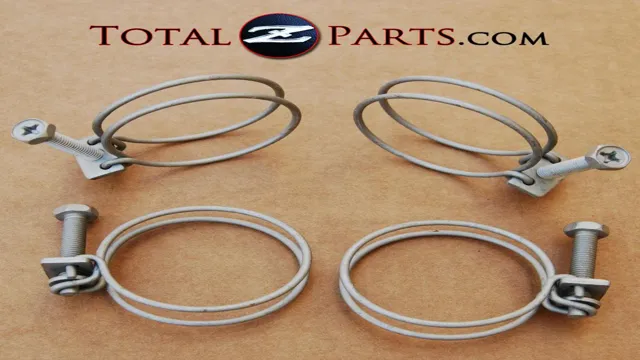
Types of Radiator Hose Clamps
When it comes to the various parts of your car, the radiator might not be something you think about often. But, it’s an essential component that keeps your engine from overheating and causing costly damage. One vital part of the radiator system is the hose clamps.
There are different types of radiator hose clamps, including ear clamps, worm gear clamps, and spring clamps. Ear clamps are simple and easy to install, as they pinch the rubber hose to the fitting. Worm gear clamps are also straightforward, but they require a screwdriver to tighten them, and they may work loose over time.
Lastly, spring clamps provide more secure and constant pressure, but they can be challenging to attach to the fitting. All three options have their pros and cons, so it’s crucial to determine which is best for your vehicle and situation. By understanding the different types of radiator hose clamps, you can ensure the proper functioning of your car’s cooling system and avoid potential overheating issues.
Determining Tightness of Radiator Hose Clamps
Are the hose clamps on your radiator tight enough? It’s an important question to ask yourself, as a loose clamp can result in coolant leaks, engine overheating, and even engine failure. Determining how tight the clamps should be can be a bit tricky, but there are a few rules of thumb to follow. Firstly, make sure the clamp is tight enough to prevent any coolant from leaking out, but not so tight that it damages the hose or restricts its flow.
A good way to test this is by gently tugging on the hose after tightening the clamp to ensure there is no give. Secondly, be aware of the material of the hose and the clamp. Different materials require different levels of tightening.
For example, if you have a silicone hose, you may need to tighten the clamp more than if you have a rubber hose. Lastly, remember that over-tightening can be just as harmful as under-tightening. So, take your time and use a torque wrench if necessary to ensure an even and snug fit.
By following these guidelines, you can ensure that your radiator hose clamps are tight enough to keep your engine running smoothly.
Using Torque Wrenches
Torque Wrenches When it comes to car maintenance, radiator hose clamps are often overlooked, especially when it comes to determining their tightness. However, it’s crucial to ensure these clamps are securely fastened to prevent coolant leakage or even engine overheating. This is where torque wrenches come in.
Simply put, a torque wrench measures the amount of force or torque applied to a fastener, like a hose clamp. To determine the correct tightness of a radiator hose clamp, first, find the recommended torque specification in your car’s owner manual. Then, use a torque wrench to tighten the clamp to that specification.
Be careful not to overtighten the clamp as this can damage the hose. Aside from providing the correct tightness, using a torque wrench also promotes consistency in tightening the clamps, ensuring that they are all securely fastened. This reduces the risk of leaks and engine damage due to improperly tightened clamps.
In conclusion, a torque wrench is an essential tool that should be part of every car owner’s maintenance kit. Taking the time to properly torque your radiator hose clamps not only ensures the longevity of your engine but also prevents costly repairs down the line.
Visual Inspection Method
When it comes to the tightness of radiator hose clamps, one effective method to ensure they are secure is visual inspection. This involves taking a close look at each clamp to check for any signs of looseness or wear and tear. If a clamp appears loose or damaged, it should be replaced immediately to prevent leaks and potential engine damage.
It’s also important to check the hoses themselves for any cracks, tears, or other damage that could cause a leak. By regularly inspecting radiator hose clamps and hoses, you can catch any issues early on and prevent costly repairs down the line. So, the keyword used here is “radiator hose clamps.
“
Pinch Test Method
One of the key indicators of a well-maintained car is a properly tightened radiator hose clamp. Not only can a loose clamp lead to a loss of coolant, but it can also cause the engine to overheat, resulting in costly repairs. Fortunately, there is an easy “pinch test” method that can determine the tightness of radiator hose clamps.
Simply give the hose a good pinch near the clamp with your fingers. If you are able to compress the hose slightly, it is too loose and needs tightening. On the other hand, if the hose feels firm and doesn’t compress easily, the clamp is secure.
It’s a quick and easy way to ensure that your engine stays cool and properly lubricated, without the need for a mechanic’s help. By performing this simple test regularly, you can catch any loose clamps before they become a major problem.
Potential Risks of Over-Tightening or Under-Tightening
When it comes to radiator hose clamps, how tight they should be can be a delicate balance. Over-tightening can lead to crushing the hose and damaging its structural integrity. This can cause leaks and potential engine damage.
On the other hand, under-tightening can cause the hose to slip off, leading to coolant leakage and overheating. It is important to follow the manufacturer’s recommended torque specifications to ensure the clamp is tightened to the appropriate level. Additionally, it is important to regularly check hose clamps for any signs of wear and tear, and to replace them if necessary.
Remember, a properly tightened hose clamp should be snug but not overly tight. A good rule of thumb is to tighten the clamp until it stops turning, and then give it an extra quarter or half turn to ensure a secure fit. By following these guidelines, you can ensure that your radiator hose clamps are properly tightened and prevent potential leaks or engine damage.
Risk of Leakage
The potential risks of over-tightening or under-tightening a component cannot be overstated, especially when it comes to leakage. Over-tightening a connector or hose can cause it to crack, resulting in leaks that can lead to serious safety issues. On the other hand, under-tightening can also cause leaks, as it allows space for air or liquid to escape.
The best way to mitigate these risks is by following the manufacturer’s instructions and guidelines for proper tightening torque. It’s also crucial to use proper tools and materials and regularly inspect all connections for any signs of wear or damage. Taking these measures can go a long way in preventing leakage and ensuring the integrity of your system.
Remember, a small leak can quickly turn into a much bigger problem, so be sure to exercise due diligence in the tightening process.
Risk of Hose Damage
When it comes to hoses, over-tightening or under-tightening can pose a serious risk of damage. Over-tightening can cause the hose to become stretched and weak, making it more susceptible to bursting. On the other hand, under-tightening can allow the hose to become loose and possibly detach from its connection point, leading to leaks and potential accidents.
It’s important to find the right level of tightness for each individual hose to avoid these risks. A helpful analogy is to think of it like Goldilocks and the three bears – not too tight, not too loose, but just right. In order to prevent hose damage and maintain safety, take the time to properly tighten each hose to its appropriate level.
Conclusion
In the world of radiator hose clamps, it’s all about balance. Too loose and you’ll be leaking coolant all over the place, but too tight and you risk crushing the hose. It’s like Goldilocks finding the perfect bowl of porridge – it has to be just right.
So, when it comes to tightening radiator hose clamps, aim for snug but not suffocating, firm but not crushing. It’s a delicate dance, but your engine will thank you for it!”
FAQs
Why are tight radiator hose clamps important?
Tight radiator hose clamps help prevent leaks in the cooling system and ensure proper flow of coolant.
What happens if radiator hose clamps are too loose?
Loose radiator hose clamps can cause leaks in the cooling system, resulting in overheating and possible engine damage.
What is the recommended torque for radiator hose clamps?
The recommended torque for radiator hose clamps varies depending on the size and type of the clamp, but typically ranges from 10-25 ft-lbs.
Should I use a torque wrench to tighten radiator hose clamps?
Yes, using a torque wrench ensures that the clamps are tightened to the correct specifications and helps prevent overtightening and damage to the hoses.
Can overtightening radiator hose clamps cause damage to the cooling system?
Yes, overtightening radiator hose clamps can cause damage to the hoses and the components they are attached to, leading to coolant leaks and potential system failure.
How often should radiator hose clamps be checked and replaced?
It is recommended to check radiator hose clamps during routine coolant system maintenance, and to replace them if they are worn, damaged, or corroded.
What are the signs of a loose or faulty radiator hose clamp?
Signs of a loose or faulty radiator hose clamp include coolant leaks, overheating, reduced heating or cooling performance, and unusual noises or smells from the engine compartment.
